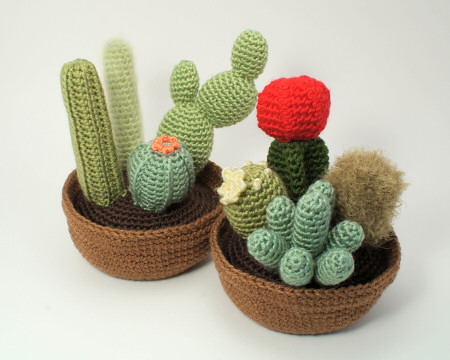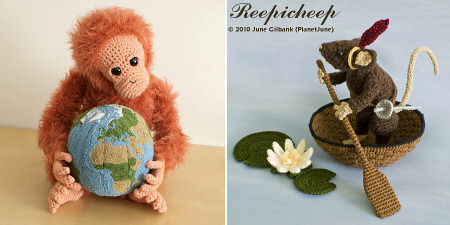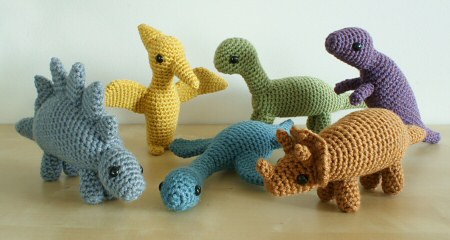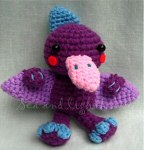My recent post inspiration/influence vs copying: drawing the line started quite a discussion! I’ve been answering questions in the comments of that post, but copyright is a huge and many-sided issue, and I’m not an expert by any means – I just know what I personally want in regard to my copyright from three different angles:
- My designs: don’t copy them
- My patterns: don’t share them
- Items made from my patterns: yes, you may sell them, provided you give me credit as the designer
Another interesting topic has emerged from the comments, and I thought I’d address that today: the process of designing. Although I shared my research process in the previous post to demonstrate how much ‘behind the scenes’ work goes into my designs, I also hoped it would be of interest to other designers, and it seems that it was. Owein commented:
This post has another very helpful purpose for me. It is a rare treat to see a talented artist’s design process. I would never try to illegally copy any of your designs, but I hope you don’t mind if I emulate your process of producing a design. In fact, I’m sure there are a few blanks that you could fill in if you were to produce a post that outlines your entire design process. I know that was not your original intention, but it is a help to those of us who would like to design unique products of our own.
Now, I can’t share my actual design process – the part that takes you from all the information and pictures I showed in the previous post to my design sketch, because it all happens inside my brain, and so it must work differently for each person. But what I can share is the factors that I balance to produce my designs. These tips don’t apply to only amigurumi designers: this basic process applies to whatever you’re designing, be it patterns, handmade products, or inventions/designs to be commercially manufactured.
Tip 1: Research, research, research
You can never have too much information in the back of your mind when you design. Unless your design is purely fantastical, knowing as much as you can about whatever you’re basing it on can’t hurt, even if your design style is miles away from realistic. Do a Google image search, check Wikipedia, visit some official or fan websites about the subject matter for your design, and maybe even consult a book or two – your local library can hold some amazing reference sources.

Example: Before I started work on my Cactus Collections (right), I visited several cactus websites to get a feel for different types of cacti, and I checked out half a dozen books on growing cacti from the library. After identifying some basic cactus types, I used the books and more websites to do more detailed research on each type.
The research stage also includes checking up on what’s already out there, not with the intent of copying it, but more to make sure that your amazingly original design doesn’t already exist. If someone else has independently come up with the same idea, you can still go ahead and make your own version, but wouldn’t it be better for you as a designer to tweak yours a bit so it’s more distinctive? Not only will this avoid any possible future accusations about copying etc, but you don’t want somebody to confuse your work with the pre-existing one and maybe buy from that person instead of you!
Example: Before starting my Pteranodon design, I looked for existing knit and crochet Pterosaur patterns (above), so I could make sure my design would be original.
Doing this step before you get too deep into your own design gives you a chance to avoid the similarities before they occur.
Tip 2: Find and follow your design aesthetic
The aim isn’t to make your design photo-realistic (unless photo-realism is your trademark style), but to convey the idea in your own style – this is where your inner artist gets to play.
You may not want all your designs to reflect exactly the same style, and of course your style will change with time, experience, and new inspirations, but however many ‘looks’ you develop, they should all be part of your overall style. It’ll help you to find recognition if your designs aren’t too eclectic and have some common stylistic elements between them. Ideally, you’d like people to be able to look at a photo of your work and say “oh, that must be a XXX design – I love his/her stuff!”.
If you’re just getting started in designing, you may not have figured out your own distinct style yet – it takes time.


You can work on developing your style with research too: try looking at photos of your favourite stuff (Pinterest is a great way to keep track!) , and figure out what it is about each that especially draws you to it. I get inspiration from other handmade work, photos of nature, products I see in shops… there’s inspiration all around if you look for it. Then look for common elements or links between the things you like, such as colour palettes, scale, level of detail and embellishment, etc etc.
The more you know about what you like, the easier it is to reflect that in your work.
Tip 3: Consider the finished product and its purpose
For example:
- Is it a pattern for others to follow? Then you need to balance the detail of the design with the ease for other people to follow it. The most wonderfully detailed design is no good if your customers give up halfway through in frustration.
- Is it a toy for young children? Then you need to consider what is attractive to a child (bright colours, simple shapes) and avoid dangers (delicate parts, choking hazards)
- Is it going to be mass-produced? Consider simple designs that can be produced with few pieces, or designs with pieces that can be created as multiples and then assembled separately, to save time.
The list could go on, but I hope you can see that there’s a delicate balance between what makes a good design in a vacuum and what makes a good design in the real world. If you actually want to sell your pattern/product (whatever it may be), it has to be functional as well as aesthetically pleasing. That’s why my art pieces (for example orang utan, Reepicheep) are far more detailed and complex than my patterns: a pattern for something like that would be hugely difficult and frustrating to follow.


Just because you can create something complex doesn’t mean you should (unless you’re designing art and it has no purpose other than to look good and/or convey your artistic message). I made the design decision to be minimalistic with my Dinosaurs (only one colour, simple stylised shapes) and yet they have become some of my bestsellers, partly because the simple design makes them a pleasure to crochet.
That’s not to say that all designs should be minimal – it’d be a boring world if they were! – just that what you leave out of your design can be as important as what you put into it. The trick is to figure out what to leave out, and why, by thinking about both form (appearance) and function (intended use).
Go Forth and Design!
If you’ve read through to this point and think you’re ready to make designs that look just like mine, then you’ve missed the point. If you’re serious about designing, you need to be original – the goal here is to create and develop your own distinctive style so that people will begin to recognise you by your work. I hope that following my tips above will help you along that path 🙂
Add your viewpoint! Join the conversation in the comments below…



















Aradia said
Here’s a great question about “your style” I know I personally prefer things as seamless as possible, as well as having as few individual pieces as possible. (I despite assembling things!) Would these points be considered as part of my style?
June said
Yes and no! There are many different aspects to your style, and some are more immediately apparent than others:
If all your designs are worked in few pieces, that definitely forms a part of your design style (the way you construct your work).
But, there may be other ways to create the same shapes that do involve seaming or attaching more pieces – and if the end product of that looks the same as your seamless version, then it’s not part of your visual style, as people wouldn’t be able to recognise the difference.
As an example: I could choose to create and attach a leg in several ways:
– crochet the leg separately and then stitch it to the body,
– work it as one piece flowing from the body and then resume crocheting the body after the leg is finished,
– surface crochet a base for the leg onto the body and then crochet out from there to complete the leg
(…I’m sure there are more options too.)
My point is that, to most people, the end result of all these would look very similar, so the method I choose to use doesn’t form part of my visual style, as you can’t immediately tell by looking at a photo that I used a special technique.
But, if I always used an uncommon method (such as the surface crochet one) in all my designs, people who looked at my patterns would grow familiar with that method as a “PlanetJune standard”, so it would form a recognisable part of my design style.
So to answer your question, yes, every design decision you make forms a part of your style, but they may not all be obvious to the casual observer.
(I should also point out that your style will grow and evolve as you do, so you should never feel constrained by any ‘style rules’ you’ve created for yourself – experimenting is a big part of creativity, and I’d hate to think that my advice in these posts might discourage that!)
Aradia said
I’m also grateful that you posted this. When I started out I really didn’t think I would ever even want to design anything, the inner workings involved to increase, decrease, change color, join, etc and so on seemed too daunting. So I started out with free patterns and sell what I make (though I don’t claim it’s my original work in designing, just effort to produce). Now I find myself getting all sorts of fun ideas of things I would like to make. Personally I always check to see if there is an existing pattern, not necessarily so I don’t copy it but just because I don’t feel the need to always “re-invent the wheel”. If you made something and the design is great and I really don’t feel that I could design something I would like better I don’t bother.
However, here’s an issue…in design there are certain mechanisms which are used to achieve certain affects. The likelihood that you will end up using a similar mechanism isn’t necessarily unlikely. So what I am getting at I suppose is that I could see how in some cases there could be strong similarities that may be completely unintentional. What then?
Then there is the note of method, this is more relevant for non crochet or knit items I think, in which there is an idea to make something, like a hand stamped card. From experience it doesn’t take much to reproduce something that may be all too similar to another’s work, even by accident.
Now my final concern is something about not making money from something. What of those efforts in which you merely wish to design a neat design that may be an artistic rendering of an existing subject (actual, art, what have you). Were you to say: “Design originally by based on the .”
June said
Good points, Aradia! I suggest you take a look at my original post, inspiration/influence vs copying: drawing the line, (and the comments on that post, where we’ve discussed some of these issues).
This definitely isn’t a black and white situation: while some scenarios are definitely fine (being inspired by things you’ve seen) and others are definitely not fine (intentionally reproducing somebody else’s design with intent to profit from it), there’s a huge spectrum of grey area in between the two and it can be hard to know where to draw the line.
I’ve seen cases where people have been too quick to point the finger and accuse others of copying, and certainly, the less original and distinctive a design is, the more chance that someone else will independently create something similar – and that’s one of many reasons for developing your own distinct style as an artist/designer.
Kara said
Thanks, June. I’ll try to keep that in mind and next time, I will make a swatch first!
Also…a hummingbird would be cool!
Smiles!
Nancy said
This has nothing to do with this post – but yes, I totally see your point! – but I saw your kingfisher post, and I thought you could use the same pattern with a few modifications to make a hummingbird! I would realllllyyy LOVE a hummingbird!
Sonja said
Hi June,
I totally agree with you and as an artist myself, illustrator and painter, I know how it feels when somebody copies an idea or piece.
But with making crochet dolls I sometimes don’t really know when to call it really ‘my own’. For instant, I made an Link doll, an original and unique one. Some parts I completely designed myself, for other parts I used free patterns as an example. I didn’t made those parts exactly as the pattern and changed the size and shape, and used them as a sort of guideline, to see how it’s done.
Like, I wanted a moveable head, there was a pattern with that, but I thought that head was too wide at the chin and too loosely on the join and not the right shape. So I totally redesigned it, the stitches aren’t similar at all any more. Now I don’t really feel that I can get the full credit for it….find that difficult to say. When the doll is done, I call it my own design, but add the names of the persons who’ve made the patterns I used as an example. But still it feels weird….what do you think?
June said
Hmmm, interesting question, Sonja. My feeling is that it depends on what you plan to do with your design:
If you’re just making a one-off doll, I think it’s okay to do as you said: call it your own design but give credit to the designers who made the patterns you based parts of it on. I think that’s fair to everyone.
If, however, you’re thinking of publishing your pattern (either free or for sale) I don’t think this is okay any more. To design patterns, you should be able to recreate those basic shapes without referring to somebody else’s pattern. If you plan to do this, I suggest you keep notes every time you make something, and before long you’ll learn the ‘pattern’ of stitch numbers, increases, decreases, etc you need to create basic shapes, and then vary them to create more interesting shapes. I don’t think you should call a pattern your own unless you created it without the assistance of anyone else’s designs.
That’s just my opinion, for what it’s worth! I hope it helps clarify things for you 🙂
Sonja said
Thanks for your quick answer June. It’s good to hear your point of view about this because I really doubted about it. Some people who saw that doll do want the pattern to make one themselves and I am going to publish it free. But, I won’t call it ‘my pattern’ then, but will think of an honest name for it.
So, thanks and have fun.
Kara said
Hi, June. I learned to crochet and up until recently have only crocheted amigurumi. I love making the dolls and think they are adorable. Of course, I think you design the best and easiest to use patterns that I’ve ever come across (really, you do such an amazing job with explanations, keeping things simple, and including wondeful pictures to help). However, recently I’ve started playing with other patterns too (hats, scarves, etc). My problem is, I know which yarns I like working with to craft different styles of amigurumi (just from trying them out and playing) BUT I have no idea how they translate to the finished product of other articles, like a hat or scarf or blanket. (I made a hat from a yarn I like but it turned out way too stiff and I was disappointed because it looked and felt all wrong). As these articles take longer to make, I don’t really have the patience or money to try out different yarns to see what the finished product might look like (I guess clothes and blankets just aren’t as fun as amigurumi to me).
So, my question for you is: do you have any advice about what types of yarn to use for crafting other projects? Or can you point me in the right direction for finding good advice on this?
Thanks!
June said
Kara, it’s not so much about the yarn as it is about the combination of yarn and hook. If your projects turn out too stiff, that means you’re using a hook that’s too small for the yarn you’re using. Everyone crochets differently, so it may be that you crochet very tightly, and always need to use a larger hook to compensate.
For almost any crochet pattern apart from amigurumi, there will usually be gauge information given in the pattern (that’s the number of stitches and rows you should have per inch). If you use the same yarn weight as the pattern suggests, and you make a swatch (a sample square using the same stitch as the pattern), you can measure it and compare it with the gauge size given in the pattern. If yours is smaller (more stitches per inch), then redo the swatch with a larger hook until your gauge matches that in the pattern. Or, whatever yarn you’re using, try out just a few rows of the pattern and see if it feels stiff and firm. If so, try going up a hook size or two, and keep experimenting until you find a yarn/hook combination that gives you a nice-feeling fabric, then unravel everything and start again using the hook you liked best. It’s worth putting in that extra work before you start so you don’t end up wasting hours making something you’re not happy with!
Chrisie said
Thanks for another informative post! I haven’t been crocheting for very long (almost a year now-since my grandma passed away and I inherited her hooks), but I would eventually like to design my own patterns. So thank you for breaking it down into something like a ‘pattern’ to be followed. 😉 I love the look of your creations and I hope I can find my own style eventually… My dream would be to make enough money from crocheting/pattern making that I won’t have to take a random retail job when my kids go to school. Thanks again! Your blog, patterns and book always come to mind first when I tell people that they CAN learn to crochet, because there are lots of good resources out there!
Jeri said
I really appreciate the fact that you will allow us to sell the finished product. I certainly respect that you don’t want us to sell your pattern. Patterns take a lot of work and rework just to get them right! I would never sell another person’s pattern – that does feel like stealing to me but I never could understand why so many patterns have a “do not sell finished item” clause. If anything, I would think that trying to sell a finished product could lead back to you. I know if I viewed a finished product and it had the credit to the designer, because I crochet, I would go back to the designer to get the pattern. Although I do have to say that I have never had a designer say no to me if I asked if I could sell the finished product. One designer asked me to not sell on Etsy, but since I have an Artfire shop, that wasn’t a problem.
But thanks again. Your patterns are really great!
June said
Thanks, Jeri! There are valid reasons for other designers to have more restrictive policies than mine regarding the sale of finished items:
I try to keep my prices reasonably low and not charge any additional fees (for licensing or anything else), because I want more people to be able to enjoy my patterns. I don’t think there’s a huge profit margin to be made from selling amigurumi as they take a long time to crochet and assemble to a high standard, so I figure that if you put the work into making one of my designs, you deserve to earn back whatever you can from selling it. And if you do well from it, you can pay me back by spreading the word about my designs and/or buying more of my patterns! It’s a win-win situation 🙂
Abigail Turner said
I really appreciated your post! I am a beginner knitwear designer. I have a few patterns that I have published and sold. I found your article to be very useful to me as a knitwear designer. You had some really great tips and helpful hints that will be of great use to me in future designs.
A lot of the time it is inside my head, my designs but I found that bit about looking to make sure that it isn’t already out there was helpful. It seems that at least in the knitting world that there are endless possibilities but on the other hand people have been doing this for hundreds of years so there is always a possibility that it may have been designed already. I also appreciate your encouragement to make a design that says that it’s you and that it is unique to you.
Thanks a bunch,
Abigail Turner
June said
You’re very welcome, Abigail. You could go crazy checking every knitwear pattern that’s ever been created to see if someone’s had the same idea, but I do recommend using Ravelry to get a feel for knit or crochet designs – it may not have a listing for every pattern in existence, but you can get a really good feeling for what’s already out there by putting some parameters into the advanced search (e.g. knit, shawl, top down, triangle, lace weight yarn) and seeing if there’s anything that’s a close match to what’s in your head – if 20 designs come up that look pretty close to what you had in mind, it might be worth trying to differentiate it in some way, especially if you want people to buy yours and not the other 20 close matches that already exist 😉 You can do it!
Fran said
Thanks for this post! I had read your previous one about copyrights and all the buzz in the comments too. I’ve been holding back from creating my own patterns for a while now, being afraid of the copyright arguments I’ve seen on a lot of craft sites and even YouTube… I don’t have a distinct style yet and I don’t want to accidentally mimic a similar style. You helped give confidence to just go ahead and do it. My style won’t develop just sitting around doing nothing!
June said
Absolutely, Fran! See what I said to Jessi above – just keep creating what you like and see what happens. It may be that you start out by making wildly differing things, but then, as you keep creating, things will start to coalesce in a certain direction. I can see a crossover now with my crochet and my polymer clay work, for instance – two totally different media, and yet the things I make in each have stylistic similarities. So yes, my advice is: go for it! (Just remember, there’s a lot more to creating a good pattern than just creating a good design… but that’s a topic for yet another post!)
Rachel Erin said
This post was very timely for me – I’ve been thinking a lot about my design aesthetic, what my look and style is, and what I’m doing right so I can do more of it.
The cacti make me want to learn to crochet. And the dinosaurs.
June said
Hee, well you should definitely learn to crochet, Rachel 😉 I should probably also mention that my ‘style development’ process happened naturally – I wasn’t even aware that I had a style until I looked at lots of pictures of my work all together and realised that there were common threads between them and a certain something that made them look distinctive from other people’s designs. But once I realised that and pinned down some of the PlanetJune characteristics, it simplified my design and decision-making processes, so it’s definitely worth doing a little self-analysis.
Jessi Brown said
Ah fabulous post! Thank you for sharing that. Its awesome to get that kind of advice from someone experienced when you have so many ideas in your head and don’t know where to start.
June said
You’re welcome, Jessi! I think just starting is the key… Just keep creating stuff that you like (not stuff that you think will be popular), and see what happens. I designed lots of things (cross stitch patterns, plush toys, polymer clay stuff) before I found an idea that people really responded to (fuzzy amigurumi) and then my whole business all blossomed from there. I never actually intended to be a crochet designer – I was just making stuff that I liked!